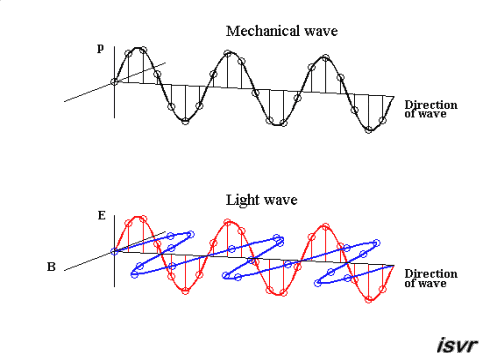Mechanical waves and light waves
Water waves and sound waves are examples of mechanical waves. Light waves are not considered mechanical waves because they don’t involve the motion of matter. Most of the mathematics and properties of mechanical waves apply to light waves. Light waves are different from mechanical waves, however, because they can travel through a vacuum. Light waves are just one type of electromagnetic wave. Other electromagnetic waves include the microwaves in your oven, radio waves, and X-rays. Light waves are regarded as a varying electric field (E) coupled with a varying magnetic field (B), at right angles to each other and to the direction of travel. This is depicted in the animation below.

An electromagnetic wave transports its energy through a vacuum at a speed of about 3.00 x 108 m/s (commonly known as c), i.e. the speed of light. The whole family of electromagnetic waves extends from gamma rays of very short wavelength (les sthan 10-10 m) to very long radio waves (greater than 103 m). Just as for mechanical waves, light waves exhibit reflection, refraction, interference and diffraction and satisfy the relation v = f λ.
Unlike transverse waves such as electromagnetic waves, longitudinal waves such as sound waves cannot be polarized. The polarization of a wave is given by the orientation of oscillations in space with respect to the disturbed medium. A polarized wave vibrates in a single plane in space. Since sound waves vibrate along their direction of propagation, they cannot be polarized.